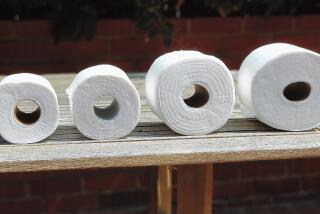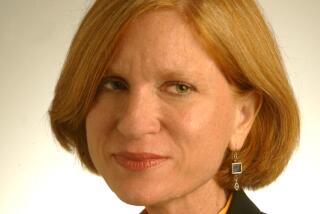2 Paper Firms to Increase Their Heft by Joining Forces : Mergers: Kimberly-Clark’s plan to buy Scott for $6.8 billion reflects growing competition in household products industry.
- Share via
Kimberly-Clark Corp. agreed on Monday to buy Scott Paper Co. for $6.8 billion in stock, creating the world’s largest facial tissue company and illustrating how growing global competition in household products is forcing many industry giants to merge.
The acquisition unites Kimberly-Clark, the maker of Huggies disposable diapers and Kleenex tissues, with Scott’s Viva paper towels, Scotties tissues and Cottonelle toilet tissue. The new firm, to be known as Kimberly-Clark, would have $11 billion in worldwide sales.
The deal would give Kimberly-Clark added heft in Europe, where it has had trouble making inroads, and increased clout with retailers in the United States. It is yet another sign of how consumer products firms are coping with sluggish domestic growth through consolidation in the United States and expansion overseas.
Together, the merged companies would be a formidable competitor to Procter & Gamble Co., a consumer products giant with sales of $30 billion. P&G--the; maker of Bounty paper towels, Charmin toilet tissue and Pampers and Luvs diapers--goes head-to-head with Kimberly-Clark and Scott across their paper product lines in the United States and competes with them in Europe in disposable diapers and feminine products.
The deal had been rumored for weeks and was greeted enthusiastically by stock analysts who follow Kimberly-Clark and Scott. They saw it as an important development in the race for growth in foreign markets.
“Whoever gets there first, whoever gets the largest shelf space, has the best chance of being very profitable and making it harder for those who come later,” said Wesley Moultrie, a paper industry analyst with Duff & Phelps credit-rating service in Chicago.
The merger is also expected to give Kimberly-Clark greater bargaining power with U.S. retailers, particularly national chains such as Wal-Mart and Target.
Kimberly-Clark would command more brands and would presumably have greater marketing dollars at its disposal, enabling it to get more space for its products in stores.
The merger is part of a wave of consolidations within the household products business. In the 1980s, P&G; acquired Richardson Vicks, the maker of Vicks VapoRub and other products. P&G; also acquired Noxell and Max Factor. More recently, American Cyanamid sold its household cleaners to S.C. Johnson, maker of Johnson Wax.
The companies’ products fit well together, analysts said. Kimberly-Clark sells higher-end brands, while Scott offers value-price products, said Bonta Austin, an analyst with Prudential Securities Research in New York. The lines fit together because retailers like to stock top brands and low-price alternatives.
“I don’t think there will be any cannibalization of sales,” she said.
Doris S. Nakamura, an analyst with Duff & Phelps in New York, said the two companies also complement each other in the so-called out-of-home market. Kimberly-Clark is weak in that area, while Scott is a leading supplier of tissue and paper towels to restaurants, workplaces and other public places.
The biggest boost would come in Europe, where latecomer Kimberly-Clark has had a tough time persuading retailers to stock its products.
Philadelphia-based Scott is Europe’s No. 1 tissue maker, with special strength in Italy, Spain, Germany and Belgium. Scott’s well-developed distribution network would give Kimberly-Clark coveted access to the market in those countries, analysts said.
William Steele, a paper industry analyst with brokerage Dean Witter in San Francisco, said Scott’s enviable position in Europe “drove the deal.”
“For Kimberly-Clark, the U.S. is sound. Mexico, except for the situation with the peso, is sound. The real variability came from Europe,” Steele said. “They were trying to build country-by-country. That is time consuming and expensive.”
The merger is not likely to raise antitrust concerns, company officials and analysts said.
Kimberly-Clark’s shares rose $4.875 to an all-time high of $63.50 in trading Monday on the New York Stock Exchange. Scott Paper’s shares were down $2.75 to $46.375.
Analysts said Scott shares fell because investors anticipated that Kimberly-Clark shares might fall before the fourth quarter, when the transaction is expected to be completed. Under the terms of the deal, Scott Paper shareholders would receive 0.765 shares of Kimberly-Clark stock. They would own 42% of the combined company.
The deal culminates a 15-month restructuring at Scott, during which its chairman, turnaround expert Albert J. Dunlap, sold $2 billion worth of assets, including health care and dog food businesses.
He also paid down $1.3 billion in debt and cut 11,000 jobs. Dunlap stands to make between $90 million and $100 million from the merger by selling his Scott shares and exercising stock options.
One fallout from the merger is expected to be more layoffs, especially involving jobs in the United States.
Kimberly-Clark said that the merger would produce immediate cost savings that would rise to $400 million by 1998 as staffs are combined and jobs are eliminated.
In announcing the merger, Dunlap cited “many synergies” that will allow the merged company to reduce costs. Kimberly-Clark said it did not yet know where the ax may fall, but in his comments, Dunlap mentioned overlap in administrative departments, such as legal, sales forces, finance and marketing.
As of last December, Kimberly-Clark employed 42,707 and Scott Paper employed 15,100.
More to Read
Inside the business of entertainment
The Wide Shot brings you news, analysis and insights on everything from streaming wars to production — and what it all means for the future.
You may occasionally receive promotional content from the Los Angeles Times.









